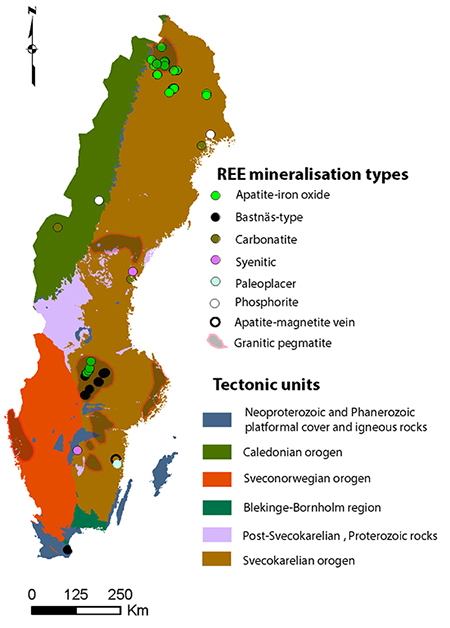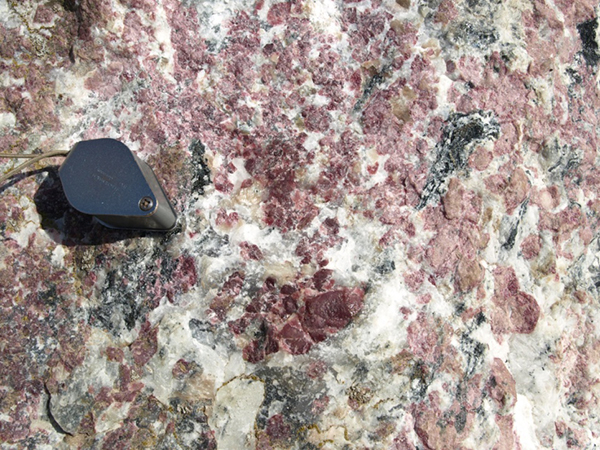REE mineralisation in Sweden
Sweden has been called the "home of the rare earth elements", due to the fact that both the first light and the first heavy rare earth elements (LREE and HREE, respectively) were discovered here during the late 18th and early 19th centuries. Yttrium (Y), ytterbium (Yb), terbium (Tb) and erbium (Er) were discovered in gadolinite from the Ytterby mine north of Stockholm, and named for their original locality. Additional HREE (such as holmium (Ho), named after Stockholm) were also subsequently discovered at Ytterby. In the Bastnäs mines near Riddarhyttan in the Bergslagen province, cerium (Ce) was discovered and described in 1804, followed by several other LREE. Sweden is now known to host a large number of REE occurrences of different genetic types, and numerous REE-bearing minerals were originally discovered in this country.
REE in alkaline intrusives
The Norra Kärr REE deposit comprises a small, complex intrusion of agpaitic rocks (peralkaline syenite) of Mesoproterozoic age in southern Sweden. Recent data from the concession holder, Tasman Metals Ltd, indicate that the deposit contains resources of REE, and Y and zirconium (Zr) with eudialyte as the main REE ore mineral. The NI 43-101 compliant REE resource is estimated as 41.6 million tonnes at 0.57 per cent total rare earth oxide (TREO), with 51 per cent of that being heavy rare earth oxides (Jonsson, 2013).
Other alkaline intrusives with potential for REE are the Särna intrusives in western central Sweden, consisting of partly cancrinite-bearing nepheline syenites, and the Almunge nepheline syenite complex east of Uppsala, which consists of several types of syenitic rocks surrounded by a fenite aureole.
REE in carbonatitic intrusives
Some of the highest concentrations of REE as a whole in Sweden, and some of the most LREE-enriched compositions, have been identified in sövite from the Alnö alkaline complex in Sweden, which includes both silicic (syenitic) and carbonatitic rocks, with higher potential for REE enrichment in the carbonatitic rocks. REE minerals within the Alnö complex include apatite, monazite, synchysite, aeschynite, fersmite, brockite, (perovskite, pyrochlore), titanite, zirkonolite, wöhlerite and Ti-andradite. North of Alnö, further carbonatite intrusions north of Söråker locally show elevated REE concentrations. Small carbonatite dykes also occur in the Kalix area, close to the Finnish border in north easternmost Sweden. They contain leucoxene, apatite and perovskite.
REE in apatite-iron oxide ores
The magnetite-(haematite)-apatite ores of Kiruna type generally exhibit anomalously high concentrations of REE. These are hosted by primary fluorapatite and later-formed phases, mainly monazite-(Ce) and allanite-(Ce). Total REE contents in the fluorapatite may reach up to weight-percent levels. Important examples of this deposit type include Kirunavaara and Malmberget in northernmost Sweden, and Grängesberg-Blötberget-Idkerberget in Bergslagen, south central Sweden.
REE in iron skarn (Bastnäs-type) deposits
The Bastnäs-type deposits are located in the Bergslagen ore province of south central Sweden, where they form a discontinuous, narrow belt of approximately 100 km length, the so-called REE-line. These types of deposits occur in skarn-altered carbonate interbedded with felsic, calc-alkaline volcanic units of Palaeoproterozoic age. LREE-enriched deposits are located mainly in the Riddarhyttan-Bastnäs area, whereas those in the Norberg district may also have HREE enrichment. Typical host minerals comprise cerite-(Ce), törnebohmite-(Ce) and allanite, as well as REE-fluorocarbonates such as bastnäsite-(Ce).
REE-U in phosphorites
There are some occurrences associated with phosphorites in Sweden, particularly the Tåsjö U-REE mineralisation. This is hosted by Palaeozoic calcareous sandstone and shales with phosphorite layers, within the lower allochton units of the Caledonian front, and contains 0.03–0.07 percent U3O8 and 0.11–0.24 per cent total REE (Gustafsson, 1979).
REE in granitic pegmatites and granites
Several granite intrusions and granitic pegmatite fields in the Swedish crystalline bedrock contain primary magmatic REE-bearing oxides, phosphates and/or silicates, and in some instances also late-magmatic/hydrothermal carbonates. Generally, these deposits are either too small or too low in grade to be commercially exploited today. REE could represent by-products from pegmatites mined for other minerals, such as feldspar or mica. The highest contents of REE are found in some pegmatite-hosted oxides, phosphates and silicates. Allanite-bearing pegmatites are common and generally have high LREE/HREE ratios.
The Näverån Th-(U)-REE-prospect, in west central Sweden, is a fracture or breccia-type mineralisation hosted by weakly foliated granite to granodiorite. Here, REE-bearing minerals include uraninite, xenotime-(Y), monazite-(Ce), "allanite" and an Y-bearing phosphate.
REE in quartzite-hosted palaeoplacer-type deposits
In the Västervik region in south eastern Sweden, several occurrences of U-rich, REE-bearing minerals have been identified in quartzite-dominated Palaeoproterozoic metasedimentary successions (e.g., the Klockartorpet and Trostad mineralisations). These are interpreted to represent palaeoplacer-type original concentrations of heavy mineral sands.
REE in apatite-magnetite vein mineralisations
In the Olserum area, close to the placer localities in the Västervik region, are several vein-hosted, REE-rich mineralisations associated with iron ore. These presently relatively unstudied deposits are apparently epigenetic, contain abundant monazite-(Ce) and xenotime-(Y) in addition to e.g. apatite, biotite and magnetite, and exhibit a relatively high proportion of HREE. Tasman Metals' Olserum deposit comprises lower grade placer material with higher grade apatite-magnetite veins. Using a TREO cut-off of 0.4 per cent, Olserum hosts an indicated mineral resource of 4.5 million tonnes at 0.6 pre cent TREO, with 34 per cent of that being HREO.
Key References
Andersson, U B (ed.). 2004. The Bastnäs-type REE mineralisations in north-western Bergslagen, Sweden. SGU Rapporter and Meddelanden. 119: 34 pp.
Gustafsson, B. 1979. Uranuppslag inom Norrbotten och Västerbotten 1979. SGU, PRAP 79056. Unpublished prospecting report. 58 pp. (in Swedish).
Gustafsson, B. 1992. Sällsynta jordartsmetaller. Regional fältkontroll 1991 av arkivuppslag. Sveriges Geologiska AB PRAP 91047. Unpublished prospecting report. 22 pp. (in Swedish.)
Jonsson, E. (ed.) 2013.The Norra Kärr REE-Zr project and the birthplace of the light REEs. SGA excursion guidebook SWE3, SWE6 & SWE7. 36–51.
Jonsson, E and Högdahl, K. 2013. New evidence for the timing of formation of Bastnäs-type REE mineralisation in Bergslagen, Sweden. In: E. Jonsson et al. (eds.), Mineral deposit research for a high-tech world. Proceedings of the 12th biennial SGA meeting. 1724–1727.
Sadeghi, M, Morris, G A, Carranza, E J M, Ladenberger, A, and Andersson, M. 2013. Rare earth element distribution and mineralization in Sweden: An application of principal component analysis to FOREGS soil geochemistry. Journal of Geochemical Exploration, 133, 160–175.



